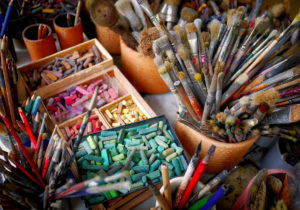Not that Kind of Progress: Tales of Setting up a New Laboratory
If you are amongst the truly lucky job applicants, you are probably setting up a laboratory as we speak. Having recently concluded our set-up, I can tell you what worked for us, and what we could have done differently. As with many things in science, there are many ways to approach this process, but here are the things that needed addressing and how we did it. N= me and my lab.
 Take pictures of your old lab before you leave: The smartest thing I ever did was document extensively the equipment, plastics, buffers, and so on that we used in my postdoc lab. This was particularly useful with my microscope purchase. I did not know the specifics of the microscope that we had used for our dissections, but I knew the model and that we needed all the zoom stops. Now, said microscope model had been out of production for years by the time I ordered it, but its new equivalent is equally great. I also spent a lot of time copying lab notebook pages I could not take, protocols in the lab, plasmid maps, primer lists, antibody logs, genotyping approaches, and chemicals. If applicable, I highly recommend copying your former lab’s Institutional Animal Care and Use Committee (IACUC) and Institutional Review Board (IRB) protocols. Yes, this all takes time, but not nearly as much time as a) calling back to your old lab and requesting copies or b) recreating these documents yourself.
Take pictures of your old lab before you leave: The smartest thing I ever did was document extensively the equipment, plastics, buffers, and so on that we used in my postdoc lab. This was particularly useful with my microscope purchase. I did not know the specifics of the microscope that we had used for our dissections, but I knew the model and that we needed all the zoom stops. Now, said microscope model had been out of production for years by the time I ordered it, but its new equivalent is equally great. I also spent a lot of time copying lab notebook pages I could not take, protocols in the lab, plasmid maps, primer lists, antibody logs, genotyping approaches, and chemicals. If applicable, I highly recommend copying your former lab’s Institutional Animal Care and Use Committee (IACUC) and Institutional Review Board (IRB) protocols. Yes, this all takes time, but not nearly as much time as a) calling back to your old lab and requesting copies or b) recreating these documents yourself.
Complete the administrative stuff: As a postdoc, I did not appreciate the amount of administrative work my mentor did. When you start your lab, you will be responsible for developing your own laboratory chemical hygiene plan, Institutional Biosafety Committee (IBC) plan, IACUC protocol, and IRB protocol. You will also need to be added to all the administrative systems so you can approve employee time, place orders, submit grants, and monitor your budget expenses. This will likely include online and/or in person training. While the least fun, most of these administrative tasks need to be completed first, before you can do the science.
Evaluate your needs: The first step of setting up a lab is identifying what types of experiments you will be performing. If you are starting a lab with a career development award, this is fairly straightforward. If you are (temporarily) unfunded, this is a more existential question. What kind of a scientists are you? What equipment do you need every single day? What equipment do you use once per month? What Cores can you use instead? Are you going to use the same tried and true methods for a technique? Or are you going to update the newest quantitative methods? I should have spent a little more time contemplating whether I would use the same old technique or implement the newest technology in the lab. Had I done so, I would have likely spent a little less money on some small equipment we will rarely use.
Decide on your initial purchasing strategy: There is no ideal strategy for purchasing. You will either pay with money or time. Shopping around for the best deals saves you money, but it costs time to collect quotes, identify less expensive alternatives, and figure out purchases outside of the procurement system. The savings, however, can be substantial. Home appliance stores, Amazon, EBay, smaller vendors, and used equipment resellers offer great savings, if you are inclined to spend the time searching. For my lab, we went with the path of least resistance by purchasing through our institution’s preferred vendors. By buying multiple pieces of capital equipment from one place, I received smaller equipment (fridges, freezers, hot plates, pipettes etc.) for free. Many vendors have new lab programs that provide considerable discounts and/or bundled items when you purchase capital equipment. I do highly recommend, and your institution may in fact require, getting multiple quotes for capital equipment. Again, there is no perfect approach—just get it done.
Order capital equipment: Every capital equipment vendor you talk to sells the best, newest, and most powerful Science Machine you have ever seen. Their competitors’ Science Machines are garbage and will break tomorrow. The good news is, if you can tolerate a bit of back and forth, you can receive really competitive pricing on said equipment through evaluating multiple quotes on similar Science Machines. This is well worth your time, as are demos of said equipment. Demos are incredibly useful if you are debating implementing new technology in the lab and/or do not have a preference between Science Machine from Science Stuff and Research Resource. In addition, expensive Science Machines come with service contracts. Talk to your network about whether you need to invest in them or not.
Staff the lab: Who will work in your lab is highly dependent on your environment and your research. Since I am in a clinical department, graduate students cost as much as postdocs, and I need additional grant support before I commit to training a graduate student. A postdoc, with a shorter training window and the ability to apply for career development awards, is a much more reasonable hire. If you are in a basic science department and work with less expensive model organisms, you may be able to afford more staff or trainees. Talk to your mentors and colleagues. See what they recommend. When to hire your first technician or bring on your first trainee (graduate student or postdoc) is also a highly personal and variable decision. I was told to hire someone very early so they could help set up the lab. I decided, instead, to hire a technician when the lab was about half set up, so said technician had something scientific to do and not just unpack boxes. This has worked out well so far and the technician has diligently generated data while completing the lab set-up process.
With your lab set-up well in hand, it is time to talk about navigating some of the other aspects of your new job, including forming a mentoring committee, navigating service, and teaching. Stay tuned for more tales!
Did I miss an important point? Do you have questions or concerns about the post? Or perhaps an anecdote to contribute! Feel free to send some electrons my way in the comments, via Twitter @PipetteProtag, or through traditional electronic mail pipette.protagonist@gmail.com






0 Comments